Family name: Eriocaulaceae Martinov
Synonym(s): [none]
Common name(s): pipewort family
*Number of genera/species: 7/1,207
List of genera records in GRIN-Global
fruit dehisced (usually with attached perianthperianth:
collective term for calyx and corolla of a flower
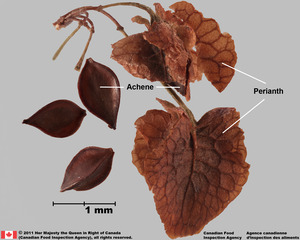 ) or seed
) or seed
Fruit a loculicidalloculicidal:
type of capsular dehiscence, opening longitudinally through the locules (compare septicidal)
 capsulecapsule:
capsulecapsule:
a dry, dehiscent fruit derived from a compound ovary , less than 3 mm long, ellipsoidellipsoid:
, less than 3 mm long, ellipsoidellipsoid:
3D shape—elliptic
, tereteterete:
approximately circular in cross section; width and thickness approximately equal
 in transection, stylar remnantsstyle base:
in transection, stylar remnantsstyle base:
remnant of a style persistent, thickened perianthperianth:
persistent, thickened perianthperianth:
collective term for calyx and corolla of a flower
 (usually corollacorolla:
(usually corollacorolla:
the inner whorl(s) of the perianth; all the petals of a flower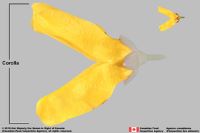 ) persistent, 2–3 seeded. Each loculelocule:
) persistent, 2–3 seeded. Each loculelocule:
structurally distinct compartment with the fruit
is filledfilled:
(of embryo) embryo fills the seed interior with the food reserves stored in the cotyledons; small amounts of endosperm may remain around the embryo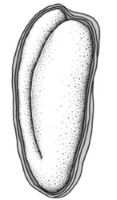 with one pendulous seed. Pericarppericarp:
with one pendulous seed. Pericarppericarp:
fruit wall or fruit coat
usually chartaceouschartaceous:
papery, papyraceous
, sometimes leatheryleathery:
texture—moderately thick, tough, and very pliable
.
Seeds oblongoblong:
2D shape—much longer than broad with nearly parallel sides, corners are rounded to fusiformfusiform:
to fusiformfusiform:
spindle-shaped; broadest at the middle and tapering at both ends , tereteterete:
, tereteterete:
approximately circular in cross section; width and thickness approximately equal
 in transection, each with micropylarmicropyle:
in transection, each with micropylarmicropyle:
an opening in the integuments of an ovule usually acting as a passage for the pollen tube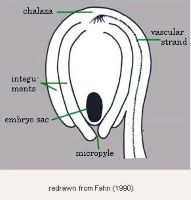 operculum, 0.2–1.5 mm long. Outer layer of seed coat is thin, and if it persists appears as covered in T-shaped hookswith hooks:
operculum, 0.2–1.5 mm long. Outer layer of seed coat is thin, and if it persists appears as covered in T-shaped hookswith hooks:
bristles or spines with curved or backwards pointing tips, or with secondary bristles along their length or short “hairs”. Inner layer of seed coat is shinyshiny:
or short “hairs”. Inner layer of seed coat is shinyshiny:
uniformly reflecting a high proportion of incident light at all angles , reddish brown to yellow, smooth or strongly sculptured. Note, seed coat surface patterns, under SEM, may help determine unknown seed to genus.
, reddish brown to yellow, smooth or strongly sculptured. Note, seed coat surface patterns, under SEM, may help determine unknown seed to genus.
Embryo rudimentaryrudimentary:
(of embryo) embryo is small and fills less than a quarter of the seed and can be variable in shapes, such as linear, spatulate, or oval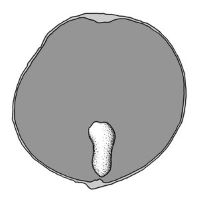 , lenticularlenticular:
, lenticularlenticular:
3D shape—lens-shaped; biconvex or capitatecapitate:
or capitatecapitate:
head-shaped; abruptly enlarged on one end to a relatively short, terminal portion
, straight, transversetransverse:
lying, situated, or placed across
to seed length and at the micropylarmicropyle:
an opening in the integuments of an ovule usually acting as a passage for the pollen tube end.
end.
Endosperm copious, mealy.
The species Eriocaulon truncatum Buch.-Ham. ex Mart. is considered a weed of rice in Indonesia.
Aquarium & Pond Plants of the World tool includes descriptions and images of genera, which may be encountered.
| Fruit | |
| Type | loculicidalloculicidal: type of capsular dehiscence, opening longitudinally through the locules (compare septicidal)  capsulecapsule: capsulecapsule:a dry, dehiscent fruit derived from a compound ovary  |
| Size range | less than 3 mm long |
| Shape(s) | ellipsoidellipsoid: 3D shape—elliptic |
| Texture | chartaceouschartaceous: papery, papyraceous , sometimes leatheryleathery: texture—moderately thick, tough, and very pliable |
| Surface relief | unknown |
| Color(s) | unknown |
| Unique features | Small, thin-walled loculicidalloculicidal: type of capsular dehiscence, opening longitudinally through the locules (compare septicidal)  capsulescapsule: capsulescapsule:a dry, dehiscent fruit derived from a compound ovary  with minute seeds. with minute seeds. |
| Seed | |
| Size range | 0.2–1.5 mm long |
| Shape(s) | oblongoblong: 2D shape—much longer than broad with nearly parallel sides, corners are rounded  , ovoidovoid: , ovoidovoid:3D shape—ovate  , ellipsoidellipsoid: , ellipsoidellipsoid:3D shape—elliptic , fusiformfusiform: spindle-shaped; broadest at the middle and tapering at both ends  |
| Surface relief | reticulatereticulate: surface relief—netted, raised walls or concave grooves forming a net-like surface pattern with flat, concave, or convex interspaces  , ribbedribbed: , ribbedribbed:surface relief—wide, prominent, linear ridges that are generally rounded and longitudinally situated on the surface  , wrinkledwrinkled: , wrinkledwrinkled:surface relief—shallow, irregular folds and furrows covering the surface; appearing overall though crumpled and then spread out  , striatestriate: , striatestriate:surface relief—having fine, parallel lines, grooves or ridges  , papillatepapillate: , papillatepapillate:surface relief—bearing minute, distinct, broad-based projections, tapering to a rounded apex  , spinyspiny: , spinyspiny:having slender, stiff, sharp projections oriented in the general plane of the structure 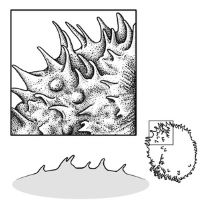 , wartywarty: , wartywarty:surface relief—distinct, rounded projections that are large relative to the fruit size; tuberculate, verrucose  |
| Color(s) | brown, red, yellow |
| Unique features | Seeds minute to small, reddish-brown to yellow, covered with T-shaped hookswith hooks: bristles or spines with curved or backwards pointing tips, or with secondary bristles along their length  or strongly ornamented, and with rudimentaryrudimentary: or strongly ornamented, and with rudimentaryrudimentary:(of embryo) embryo is small and fills less than a quarter of the seed and can be variable in shapes, such as linear, spatulate, or oval  embryo and copious mealymealy: embryo and copious mealymealy:loose, dry, and disintegrating in finely granular pieces like meal or flour endosperm. |
| Other | |
| Embryo | rudimentaryrudimentary: (of embryo) embryo is small and fills less than a quarter of the seed and can be variable in shapes, such as linear, spatulate, or oval  , lenticularlenticular: , lenticularlenticular:3D shape—lens-shaped; biconvex  or capitatecapitate: or capitatecapitate:head-shaped; abruptly enlarged on one end to a relatively short, terminal portion , straight, transversetransverse: lying, situated, or placed across to seed length and at the micropylarmicropyle: an opening in the integuments of an ovule usually acting as a passage for the pollen tube  end end |
| Nutritive tissue | endosperm copious and mealymealy: loose, dry, and disintegrating in finely granular pieces like meal or flour |
Pantropical, especially America, and extending into some temperate regions.
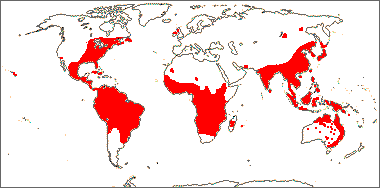
Distribution map courtesy of Angiosperm Phylogeny Website.
Baskin and Baskin 2021Baskin and Baskin 2021:
Baskin C and Baskin J. 2021. Relationship of the lateral embryo (in grasses) to other monocot embryos: A status up-grade. Seed Science Research 31 (3): 199-210. doi:10.1017/S0960258521000209; Dahlgren et al. 1985Dahlgren et al. 1985:
Dahlgren RMT, Clifford HT, and Yeo PF. 1985. The families of the monocotyledons: structure, evolution, and taxonomy. Springer-Verlag, Berlin. 520 pp.; Flora of Australia 2021+Flora of Australia 2021+:
Flora of Australia. Australian Biological Resources Study, Canberra. Accessed January 2021–March 2024. URL: http://www.ausflora.org.au; Flora of North America Editorial Committee 1993+Flora of North America Editorial Committee 1993+:
Flora of North America Editorial Committee, eds. 1993+. Flora of North America North of Mexico [Online]. 22+ vols. Flora of North America Association, New York and Oxford. Accessed January-March 2024. URL: http://beta.floranorthamerica.org.; Kirkbride et al. 2006Kirkbride et al. 2006:
Kirkbride JH, Jr, Gunn CR, and Dallwitz MJ. 2006. Family guide for fruits and seeds, vers. 1.0. Accessed September 2020-January 2022. URL: https://nt.ars-grin.gov/seedsfruits/keys/frsdfam/index.cfm .; Kubitzki et al. 1990+Kubitzki et al. 1990+:
Kubitzki K et al., eds. 1990+. The families and genera of vascular plants. 7+ vols. Berlin etc.; Stevenson and Loconte 1995Stevenson and Loconte 1995:
Stevenson DW and Loconte H. 1995. A cladistic analysis of monocot families. In: Rudall PJ, Cribb PJ, Cutler DF, and Humphries CJ, eds. Monocotyledons: Systematics and Evolution. Royal Botanic Gardens, Kew.; Zhengyi et al. 2004+Zhengyi et al. 2004+:
Zhengyi W, Raven PH, and Deyuan H. 2004+. Flora of China [online]. 25 vols. Science Press, Beijing China & Missouri Botanical Garden, St. Louis USA. Accessed January–March 2024. http://flora.huh.harvard.edu/china/
*The number of genera and species is based on Christenhusz and Byng 2016Christenhusz and Byng 2016:
Christenhusz MJM and Byng JW. 2016. The number of known plant species in the world and its annual increase. Phytotaxa 261 (3): 201-217. https://doi.org/10.11646/phytotaxa.261.3.1, which may differ from the number of genera in GRIN-Global.